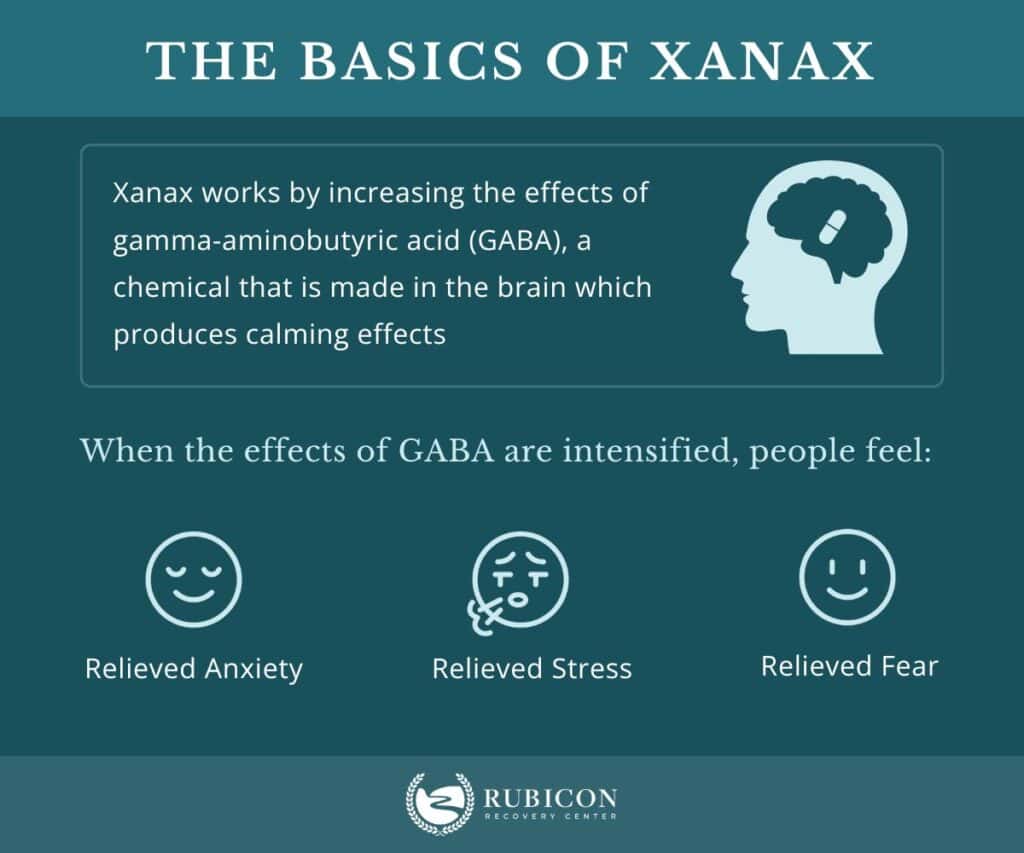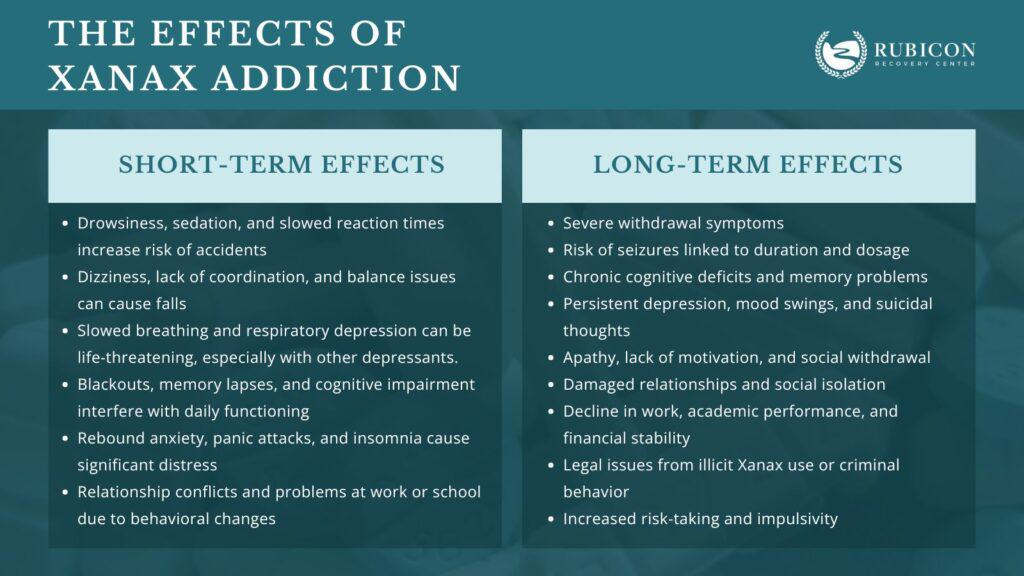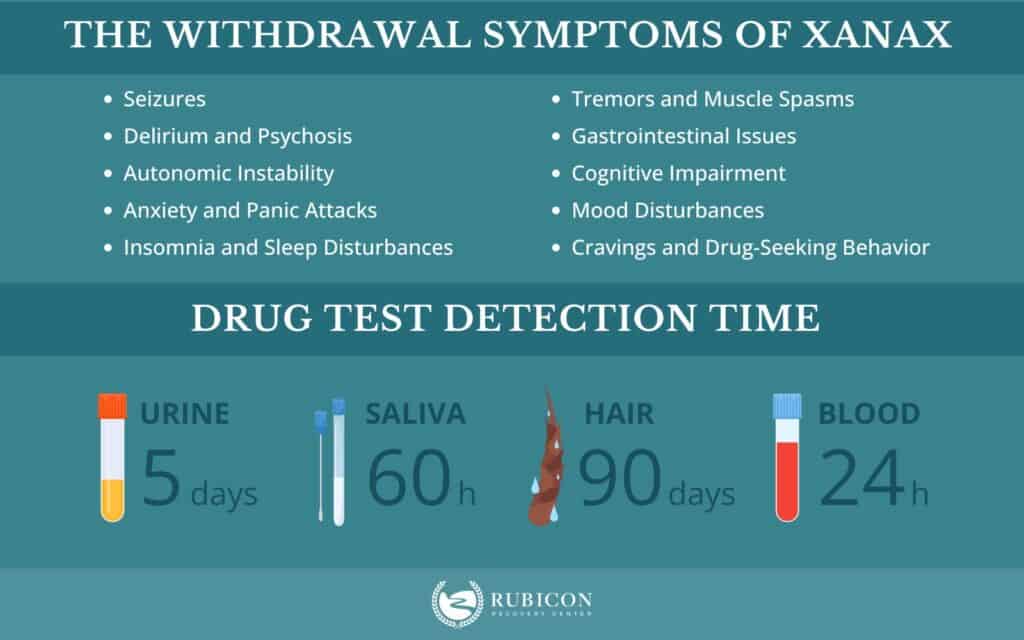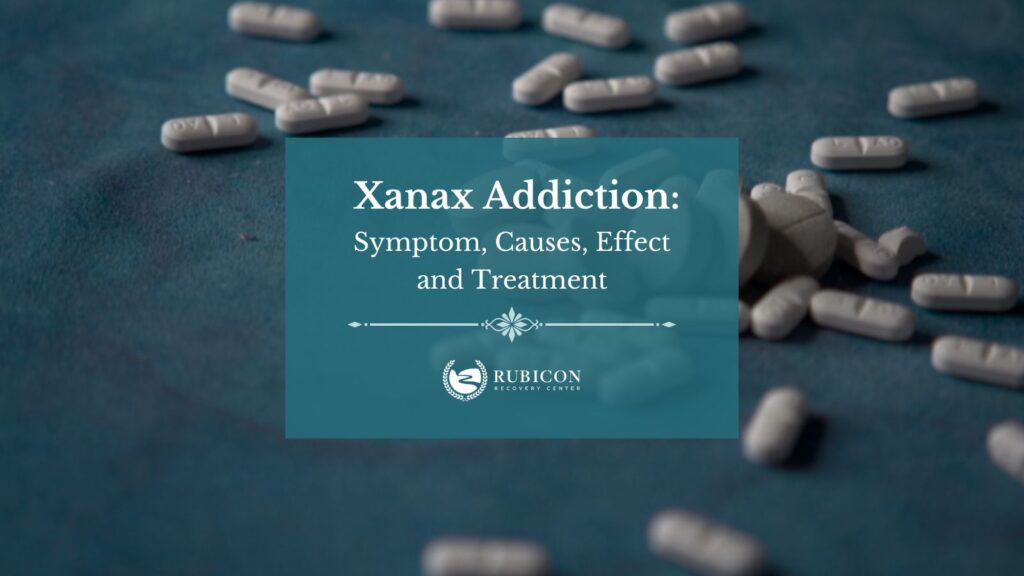Xanax has become one of the very common drugs of abuse abuse and cause of addiction in recent times among the young and old. According to research by Maust, et al (2019), titled Benzodiazepine Use and Misuse Among Adults in the United States, misuse of Xanax accounted for 17.2% of overall use and misuse of Xanax without a prescription was the most common type of misuse, with a friend or relative being the most common source.
Symptoms of Xanax addiction include drowsiness, confusion, memory problems, and dependence. The main causes of Xanax addiction are overprescription, recreational use, and underlying mental health issues.
Effects of Xanax addiction can include respiratory depression, seizures, and even death in severe cases. Treatment options for Xanax addiction typically involve medically supervised detox, psychotherapy, and long-term recovery support.
What is Xanax Addiction?

Xanax addiction is the compulsive and uncontrolled use of the benzodiazepine drug Xanax (alprazolam), despite the negative consequences it can have on a person’s life.
Xanax is a widely-prescribed medication used to treat anxiety and panic disorders. However, it can be highly addictive, especially when taken for extended periods or at high doses.
Xanax addiction involves rapidly increasing tolerance, with users taking 20-30 pills daily to achieve effects. Stopping Xanax abruptly can cause dangerous withdrawal symptoms like anxiety, insomnia, and tremors. Professional treatment and medically-supervised detox are crucial to safely overcoming Xanax dependence and avoiding potentially life-threatening complications associated with quitting the drug cold turkey.
What are the Signs and Symptoms of Xanax Addiction?
People with Xanax addiction display physical, psychological, and social symptoms including drowsiness, lack of coordination, endless headaches and muscle aches, preoccupation with Xanax use, unexplained mood changes, social withdrawal, and relationship challenges.
- Drowsiness, fatigue, and sedation
- Slurred speech and lack of coordination
- Dizziness, lightheadedness, and balance issues
- Nausea, vomiting, and loss of appetite
- Headaches and muscle aches
- Respiratory depression and shallow breathing
- Seizures and tremors when use is stopped
- Taking Xanax in higher doses or more frequently than prescribed
- Continuing to use Xanax despite negative consequences
- Preoccupation with obtaining and using the drug
- Trying to get multiple Xanax prescriptions from different doctors
- Neglecting responsibilities, hobbies, and relationships
- Isolating from friends/family in order to use Xanax
- Mood changes like irritability, aggression, and depression
- Difficulty concentrating, poor memory, and cognitive impairment
- Denial about the severity of the problem and need for help
- Problems at work, school, or home due to Xanax use
- Financial difficulties from spending money on the drug
- Relationship conflicts and social withdrawal
- Legal troubles related to obtaining or using Xanax
- Risky behaviors like driving under the influence
The combination of these physiological, psychological, and functional symptoms is highly indicative of Xanax addiction, which requires comprehensive professional treatment for recovery.
What are the Effects of Xanax Addiction?
Xanax addiction typically progresses from mild short term effects like drowsiness, sedation, dizziness to more troubling long term effects seizures, tremors, persistent depression and anxiety, and chronic cognitive deficits.

Short-Term Effects:
- Drowsiness, sedation, and slowed reaction times leading to increased risk of accidents and injuries
- Dizziness, lack of coordination, and balance issues that can cause falls and other accidents
- Slowed breathing and respiratory depression that can be life-threatening, especially when combined with other central nervous system depressants like alcohol
- Blackouts, memory lapses, and cognitive impairment that can interfere with work, school, and daily functioning
- Rebound anxiety, panic attacks, and insomnia when the drug wears off, causing significant distress
- Relationship conflicts and problems at work or school due to behavioral changes and unreliable functioning
Long-Term Effects:
- Research by O’Brien, C. P. (2005), titled Benzodiazepine use, abuse, and dependence. The Journal of clinical psychiatry, 66 Suppl 2(Suppl 2), 28–33, mentions that Xanax withdrawal can precipitate severe, life-threatening seizures, tremors and psychosis, especially among individuals who have been using the drug for an extended period. The study found that the risk of seizures during Xanax withdrawal is directly related to the duration and dose of prior use.
- Chronic cognitive deficits, memory problems, and reduced mental processing speed and acuity
- Persistent depression, mood swings, anhedonia (lack of pleasure), and suicidal ideation
- Apathy, lack of motivation, and withdrawal from previously enjoyed hobbies and social activities
- Social isolation, damaged relationships, and loss of important social support systems
- Decline in occupational performance, academic achievement, and overall financial stability
- Legal troubles stemming from obtaining Xanax through illicit means or engaging in criminal behavior to sustain the addiction
- Increased risk-taking and impulsivity, including drunk driving and other dangerous activities
The short-term and long-term consequences can be devastating if the addiction is allowed to progress unchecked.
How does Xanax addiction impact the brain to cause cognitive deficits?
According to a study by Stewart, S. A. (2005). The effects of benzodiazepines on cognition. The Journal of clinical psychiatry, 66 Suppl 2(Suppl 2), 9–13, Xanax enhances the effects of gamma-aminobutyric acid (GABA) in the brain. Chronic Xanax use has been found to disrupt the normal functioning of GABA receptors, leading to impairments in memory formation and recall.
Another study by Barker, M. J., Greenwood, K. M., Jackson, M., & Crowe, S. F. (2004). Cognitive effects of long-term benzodiazepine use. CNS drugs, 18(1), 37–48 mentioned that Xanax addiction can slow down information processing and impair sustained attention, as the drug’s sedative effects interfere with normal cognitive processing.
What are the Causes of Xanax Addiction?
Xanax addiction is caused by several factors including physiological dependence, recreational abuse, other mental health problems, and genetic predispositions.
1. Physiological Dependence
According to research by Longo, L. P., & Johnson, B. (2000). Addiction: Part I. Benzodiazepines – side effects, abuse risk and alternatives. American family physician, 61(7), 2121–2128, Xanax is a highly potent benzodiazepine that acts on the gamma-aminobutyric acid (GABA) receptors in the brain. With repeated use, the brain can become dependent on the presence of Xanax to maintain normal functioning, leading to tolerance and withdrawal symptoms when use is discontinued
2. Recreational Abuse
A study by Votaw, V. R., Geyer, R., Rieselbach, M. M., & McHugh, R. K. (2019). The epidemiology of benzodiazepine misuse: A systematic review. Drug and alcohol dependence, 200, 95–114, revealed that Xanax is sometimes used recreationally for its calming, euphoric, and sedative effects. This type of non-medical use can quickly lead to addiction, especially among individuals predisposed to substance abuse.
3. Co-occurring Mental Health Disorders
Individuals with pre-existing mental health conditions, such as anxiety, depression, or post-traumatic stress disorder, may be more likely to be prescribed Xanax and develop an addiction. The self-medicating behavior can reinforce the addiction cycle.
4. Genetic and Environmental Factors
Research suggests that both genetic predisposition and environmental influences, such as exposure to trauma or stress, can increase an individual’s vulnerability to developing a Xanax addiction. Genetics is a major player in addiction to any drug type
Xanax addiction is also caused by:
- Ease of accessibility and prescription
- Lack of awareness about addiction potential
- Self-medication for anxiety or insomnia
- Peer influence and social pressures
- Comorbid substance use disorders
- Misperception of Xanax as a “safe” drug
- Overprescription by healthcare providers
- Lack of education about proper use
- Ineffective addiction treatment or relapse
- Societal stigma and barriers to seeking help
- Neurochemical imbalances in the brain
- Chronic medical conditions requiring long-term use
- Cognitive distortions and irrational beliefs
- Emotional dysregulation and poor coping mechanisms
The multifaceted nature of Xanax addiction underscores the importance of a comprehensive, individualized approach to treatment that addresses the physiological, psychological, and environmental factors contributing to the disorder.
What are the Withdrawal Symptoms of Xanax?

The withdrawal symptoms associated with Xanax (alprazolam) addiction can be severe and life-threatening. Some of the key withdrawal symptoms include:
- Seizures: Xanax withdrawal can precipitate severe, potentially fatal seizures, especially in individuals who have been using the drug for an extended period.
- Delirium and Psychosis: Abrupt discontinuation of Xanax can trigger episodes of delirium, characterized by confusion, disorientation, and hallucinations. Withdrawal-induced psychosis has also been reported.
- Autonomic Instability: Xanax withdrawal can cause significant disturbances in the autonomic nervous system, including rapid heartbeat, profuse sweating, and severe temperature dysregulation.
- Anxiety and Panic Attacks: As the brain struggles to regain its normal balance without Xanax, heightened anxiety and panic attacks are common withdrawal symptoms.
- Insomnia and Sleep Disturbances: Individuals going through Xanax withdrawal often experience severe insomnia, nightmares, and disrupted sleep patterns.
- Tremors and Muscle Spasms: Withdrawal can lead to uncontrollable tremors and muscle spasms, which can be both physically and psychologically distressing.
- Gastrointestinal Issues: Nausea, vomiting, diarrhea, and loss of appetite are frequently reported Xanax withdrawal symptoms.
- Cognitive Impairment: Withdrawal can result in memory problems, difficulty concentrating, and other cognitive deficits.
- Mood Disturbances: Depression, irritability, and mood swings are common during Xanax withdrawal.
- Cravings and Drug-Seeking Behavior: The intense desire to use Xanax again can drive individuals to engage in compulsive, drug-seeking behavior.
The severity and potential lethality of these withdrawal symptoms underscore the importance of medically supervised detoxification and comprehensive addiction treatment when discontinuing Xanax use.
What are the Treatment Options for Xanax Addiction?
Treatment options for fentanyl addiction include medication assisted treatments, holistic and behavioral therapies, support and counseling, and relapse prevention.
1. Medically Supervised Detoxification
Medically supervised detox is crucial for safely managing Xanax withdrawal symptoms, which can be severe and even life-threatening. Under medical supervision, healthcare professionals can monitor vital signs, administer medications to alleviate withdrawal symptoms, and ensure the patient’s safety throughout the detox process.
2. Tapering and Cross-Tapering
Gradual dose reduction, known as tapering, helps minimize withdrawal symptoms and improves the likelihood of successful Xanax discontinuation. Cross-tapering involves transitioning the patient to a longer-acting benzodiazepine before tapering, which can further mitigate withdrawal effects.
A study by Morin et al. (2005) titled “Long-term outcome after discontinuation of benzodiazepines for insomnia: a survival analysis of relapse” found that gradual dose reduction, or tapering, of benzodiazepines, including Xanax, was associated with reduced risk of relapse and improved long-term outcomes for individuals with benzodiazepine dependence.
Additionally, the study suggested that cross-tapering, where patients are transitioned to longer-acting benzodiazepines before tapering, may further reduce withdrawal symptoms and facilitate successful discontinuation of Xanax with fewer complications.
3. Cognitive-Behavioral Therapy (CBT)
CBT addresses the psychological aspects of Xanax addiction by identifying and modifying maladaptive thought patterns and behaviors. It helps individuals develop coping strategies, manage triggers, and prevent relapse by fostering healthier habits and attitudes towards drug use.
4. Medication-Assisted Treatment (MAT)
MAT involves using medications such as flumazenil, gabapentin, or antidepressants to manage withdrawal symptoms and cravings during Xanax addiction treatment. These medications can help alleviate discomfort and reduce the risk of relapse during the recovery process.
5. Residential or Inpatient Treatment
For individuals with severe Xanax addiction, residential or inpatient treatment programs offer intensive care and support in a structured environment. These programs provide round-the-clock medical supervision, therapy sessions, and holistic interventions to address all aspects of addiction and facilitate long-term recovery.
6. Outpatient Treatment
Outpatient treatment offers flexibility for individuals with milder forms of Xanax addiction or those who cannot commit to residential programs. It typically involves regular therapy sessions, medical monitoring, and support groups while allowing patients to continue with their daily activities and responsibilities.
7. Continuing Care
Continuing care, also known as aftercare or relapse prevention, is essential for maintaining recovery after completing initial treatment. It includes ongoing therapy, support group participation, medication management, and lifestyle adjustments to reinforce sobriety, address any relapse triggers, and promote long-term wellness and stability.
A study by McKay et al. (2005) titled “Effectiveness of Continuing Care Interventions for Substance Abusers: Implications for the Study of Long-Term Effects” found that individuals who participated in continuing care programs following initial treatment for substance abuse, including benzodiazepine addiction, had significantly lower rates of relapse compared to those who did not engage in continuing care.
Specifically, the study demonstrated that ongoing support, therapy, and monitoring provided through continuing care interventions were associated with sustained abstinence and improved long-term outcomes for individuals recovering from Xanax addiction.
What are the Different Forms of Xanax?
Xanax (alprazolam) is available in several different forms, including:
- Immediate-release tablets
- Extended-release (ER) tablets
- Orally disintegrating tablets
- Liquid solution
- Generics and brand-name formulations
The immediate-release and extended-release tablets are the most common forms of Xanax prescribed. The orally disintegrating tablets and liquid solution are less frequently used. Both brand-name and generic versions of Xanax are available.
What are the different slang names for Xanax?
Popular slang names for Xanax include:
- Xannies
- Bars
- Benzos
- Z-bars
- Xanbars
- Handlebars
- Footballs
- Blue footballs
- Yellow school buses
- White sticks
What are the Law Enforcement Efforts
In the United States, law enforcement efforts targeting Xanax (alprazolam) abuse and distribution have intensified in recent years.
Enforcement Efforts
Law enforcement agencies have increased their focus on cracking down on the illegal diversion and trafficking of Xanax. This includes undercover operations, surveillance, and targeted raids to disrupt supply chains and apprehend individuals involved in the illicit Xanax trade.
Drug Control Policies
Xanax is classified as a Schedule IV controlled substance under the Controlled Substances Act. This classification reflects the drug’s potential for abuse and dependence. Strict regulations govern the prescription, distribution, and dispensing of Xanax, with healthcare providers and pharmacies closely monitored.
Legal Implications and Consequences
Possessing, distributing, or manufacturing Xanax without a valid prescription can result in significant legal consequences, such as fines and imprisonment. Penalties can be enhanced for offenses involving large quantities or if the drug is used in the commission of other crimes.
Role of Law Enforcement
Law enforcement agencies, including the Drug Enforcement Administration (DEA), play a crucial role in combating the illegal Xanax trade. They work to identify and disrupt drug trafficking organizations, seize illicit Xanax shipments, and prosecute individuals involved in the unlawful distribution and abuse of the drug.
Overall, the U.S. government has adopted a multi-pronged approach, combining strict drug control policies, enhanced law enforcement efforts, and public awareness campaigns, to address the growing issue of Xanax misuse and addiction in the country.
Struggling with Xanax Addiction?
If you’re battling Xanax addiction, you’re not alone. Our New Jersey rehab offers personalized support and treatment to help you overcome this challenge. Don’t let addiction control your life any longer—reach out today to our compassionate team for the guidance and care you deserve in our xanax rehab in nj. Your recovery journey starts here.
Frequently asked questions
What is the difference between Fentanyl and Xanax?
Xanax (Alprazolam) and Fentanyl differ in drug class and use: Xanax treats anxiety, while Fentanyl relieves severe pain. Xanax enhances GABA for relaxation; Fentanyl binds to opioid receptors for pain relief. Xanax is a Schedule IV drug, less potent than Fentanyl, a Schedule II opioid with a high overdose risk.
What happens when Xanax and Meth are used together?
Mixing Xanax with methamphetamine is extremely dangerous and potentially lethal. Interactions can lead to heart attacks, slowed breathing, unresponsiveness, strokes, and dizziness. Combining benzodiazepines with other meth can have lethal consequences due to the contrasting effects on the body, leading to unpredictable reactions and long-term complications.
Share This Post
